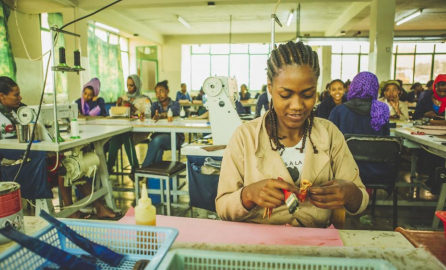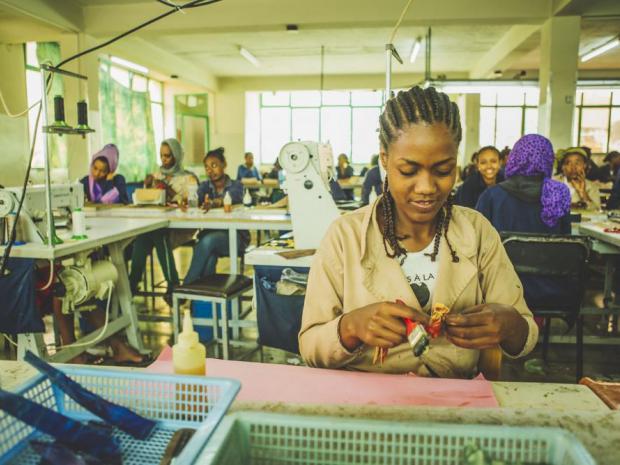Trade and the private sector are expected to play a crucial role in the SDGs and their implementation, from creating jobs to ensuring that growth benefits the economy and the people, through promoting labour and environmental standards. But some question how increased trade flows and economic growth will actually benefit the poorest populations. A panel at the European Development Days addressed concerns and shared insights into how development assistance can better use trade as an enabler of inclusive and sustainable development.
The debate came as the EU starts implementing its new ‘Trade for All’ strategy and will revise its ‘Aid for Trade’ strategy – the assistance it offers partner countries to develop their trading capacity.
Least developed countries already have non-reciprocal tariff- and quota-free market access to the EU. But many remain dependent on a narrow range of commodity exports, and lack the transport infrastructure, certification and quality standards to make the most of their market access. The EU spent €11.7 billion supporting these areas through its Aid for Trade funding in 2013, as part of its ODA budget.
During the discussion on ‘The development and trade link and the Agenda 2030’, panelists suggested how the EU can improve its support and help reach development goals through its trade agreements.
Focus on Jobs and Youth
According to San Bilal, panel moderator and Head of the Economic Transformation and Trade programme at the European Centre for Development Policy Management (ECDPM), the success of trade deals should be measured not only by the volume of trade flows, but by the number and quality of jobs generated.
Unemployment and lack of economic opportunity, especially among young people, are key challenges facing developing and developed countries alike. It is a particularly pressing issue in Africa, which will be home to half the world’s young population by 2050. When Africa “thinks about the kind of trade it wants,” said Bilal, “decent job creation should be at the heart.”
Many African nations depend on exporting commodities, the legacy of a colonial economic model in which Africa was a source of raw materials for industrialised powers. But it is not sustainable: “Exporting raw materials is not necessarily very labour intensive. If you want to create new sustainable jobs you need to focus on the issue of industrialisation,” said Bilal.
It is a term slowly gaining popularity in development circles, but Bilal urged donors “to embrace it more forcefully”. He highlighted agricultural processing and light manufacturing such as the textile industry as sectors which could create higher value added employment by processing raw materials locally, rather than exporting raw materials and importing the finished products at cost. “Technological advances or meeting higher product standards is not an end in itself – the purpose should be how we can create value addition,” said Bilal.
A parallel investment in education and vocational training will be crucial to make sure young people have the skills needed to participate in the new sectors.
Focus on Financing
Donors and multilateral development banks have an important role to play in supporting the trading infrastructure and the productive capacity that will allow businesses to grow and export.
Arancha González, Executive Director of the International Trade Centre (a joint agency of the United Nations and the World Trade Organization), outlined her priorities. Among hard infrastructure projects she highlighted the need for “roads, digital connectivity, harbors, border postings”, and in terms of soft infrastructure, “boosting competitiveness of SMEs, helping them improve quality, productivity, packaging, labelling, so they can be connected to markets.”
According to Stefan Nalletamby, vice president of the African Development Bank (AfDB), “a lot of European banks pulled out of Africa after 2008-9,” making it harder to raise funds for infrastructure projects. He pointed out that infrastructure is generally funded by public savings in Europe through the bond market, but in Africa the capital markets are not strong enough. AfDB has a trade finance group which lends $800m a year.
|
View from a European Development Days panel on Engaging the Private Sector For Grete Faremo, Under-Secretary-General and Executive Director of the United Nations Office for Project Services (UNOPS), “it’s working with the private sector that will make a difference,” above ODA or national resource mobilization. In the following video she discusses new kinds of partnerships:
|
How to better combine all the above for increased relevance and impact is the challenge ahead for international cooperation and development.
Focus on Regional Integration
The session heard how EU trade deals with developing countries must support the development of local and regional markets and regional integration.
In June a new Economic Partnership Agreement (EPA) was signed between the EU and six members of the South Africa Development Community (SADC), ranging from least developed countries Lesotho and Mozambique to upper middle income countries Namibia and Botswana and regional heavyweight South Africa.
Botswana, Lesotho, Mozambique, Namibia and Swaziland will get duty-free and quota-free access to the EU market and South Africa will have additional access. In the other direction, the agreement lets the EU sell products including meat and cheese to the SADC partners, but allows them to protect sensitive products with safeguards which can be deployed if imports from the EU grow too quickly.
Meanwhile EPAs with East Africa and West Africa are on hold. (See here for an overview of the EU’s regional EPAs.)
An EPA between the East African Community (EAC) and the EU was signed by Kenya and Rwanda on 31 August, but is awaiting signatures from the rest of the group. The deal will allow immediate tariff- and quota-free exports from the EAC to the EU, and a reduction of tariffs on 83% of EU exports to the EAC by 2030. Four of the five members of the EAC (Tanzania, Uganda, Burundi and Rwanda) already enjoy tariff-free exports to the EU under the ‘Everything But Arms’ agreement. Meanwhile without a deal, Kenya, as it is classed as a middle income developing country, would need to pay between 4.5% - 19.5% on its exports - impacting its valuable cut flower, fruit and vegetable exports. The rest of the EAC leaders were expected to sign in July but have postponed till January, with Tanzania and Uganda citing Brexit uncertainty as well as anxiety about EU exports threatening their domestic markets.
A similar deal with the Economic Community of West African States (ECOWAS) has yet to be signed by all. While 13 members have signed, Nigerian ministers fear that it would threaten regional trade – something the grouping is increasingly keen to promote, having recently agreed to apply a common external tariff from January 2017. Meanwhile Ghana, one of ECOWAS’s higher-exporting members, went ahead and ratified an interim EPA to avoid a bill on its exports into the EU, joining its neighbour Ivory Coast which signed an interim EPA in 2007.
“We have a big problem if countries would be forced to preserve preferential market access to Europe to sign individual agreements,” said Bilal. “They would like to give priority to their own integration process but the economic reality is they cannot face higher barriers to trade for exports to Europe, so they feel forced to choose between their integration process and what’s happening in Europe.”
“The best way forward is to preserve regional unity and the integrity of existing custom unions, i.e. to make a collective regional decision (for ECOWAS and for EAC) to either sign an EPA, or not,” said Bilal.
Focus on Harnessing Power of Consumers
Trade agreements can help push businesses to meet environmental and labour regulations, as well as promoting social protection systems for workers.
But the way to achieve this is complex, as it is not straightforward or even desirable to embed these standards in trade agreements when countries don’t have a national framework in place. “There is a limit to using trade agreements to lock in or induce reforms,” said Bilal. “They need to be built from within. It can be accompanied, it can be stimulated, but it cannot be driven from the outside.”
© International Trade Centre Ethical Fashion Initiative/Louis Nderi
Consumers can build up pressure if increased awareness is translated into increased demand for sustainable products. With information and choice, they can push businesses to end unsustainable and unethical practices.
However, clearer labelling and transparent criteria for different labels are needed to help consumers make informed choices. “Consumers sometimes get fooled by a label that’s green and that says eco product or sustainable product, and we don’t know what the criteria are behind it,” said Bilal.
Mobile technology is one solution, making it possible for consumers to quickly access information about a product’s provenance, including who has made it and the working conditions.
© International Trade Centre Ethical Fashion Initiative/Marie Arago
One example highlighted by González is the Ethical Fashion Initiative, which connects 8,000 artisans in Kenya, Mali, Burkina Faso, Haiti and Nepal to international fashion houses and their shoppers. By scanning the label, consumers can learn the story of the accessory, shoe or textile and its impact on people.
Women earning $1 a day before they were part of the scheme are now making up to $20 a day, changing their lives and the opportunities they can offer their families.
In the following video, Arancha González explains the scheme, and outlines her priorities for the trade – development link:
Trade and the private sector will indeed play a crucial role in creating a SDG economy – one that offers opportunities for decent jobs and is shared by all. Achieving this transformation and eradicating poverty will require rethinking our economic and social policies, as well as the way donors conceive and implement their development cooperation.
Group
Public group on Private Sector, Trade & Regional Integration
This collaborative piece was drafted with input from Ruth Hoekstra from DEVCO with support from the capacity4dev.eu Coordination Team.




Log in with your EU Login account to post or comment on the platform.